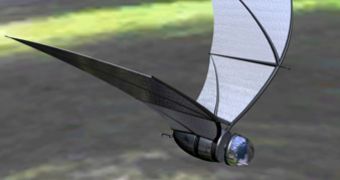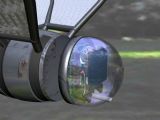The 'bat' is only the latest of the series of Unmanned Aerial Vehicles - UAV for short - designed to gather information about enemy sites and urban combat zones, capable of relaying data related to sight, sound and smell back to the command post to be used as intelligence. The 'bat' has been designed by the University of Michigan College of Engineering, during a five-year development stage, with a budget of more than 10 million dollars.
The U-M Center for Objective Microelectronics and Biomimetic Advanced Technology, or COM-BAT, has the chance to extend its development of the 'bet' for another five years and its budget to another 12 million US dollars. Most of the study involves the use of microelectronic systems, such as sensors and communication tools to be used in the build of micro-aerial vehicles. The design includes tiny stereo cameras, multiple microphones for surround sound caption and a series of sensors against poisonous gases and nuclear radiation detection.
Additionally, the 'bat' could one day benefit of a low-power radar systems and advanced navigation system, to find its way in poor weather or night conditions. If developed, the tiny UAV will be powered with lithium-ion batteries which could be recharged through various renewable energy sources like solar energy, wind or even vibrations resulting during flight, and relay intelligence towards troops on the ground by radio signal.
COM-BAT director and professor in the U-M Department of Electrical Engineering and Computer Science, Kamal Sarabandi, says that: "These are all concepts, and many of them are the next generation of devices we have already developed. We're trying to push the edge of our technologies to achieve functionality that was not possible before."
COM-BAT is a collaboration between the University of California Berkeley and the University of New Mexico, in an effort to expand the Army's horizons towards the use of small subsystems to be used as self-directed sensors in real life events. "Bats have a highly-attuned echolocation sense providing high-resolution navigation and sensing ability even in the dark, just as our sensor must be able to do," said Sarabandi.
The 'bat' has the ability to locate itself in space, in the same way that bats have the capability of sonar detection to orientate. It weighs just 125 grams, it has 15 centimeters in length and operates on about 1 Watt of power.
COM-BAT researchers believe that by improving the technology in the field of solar cells efficiency, a vehicle with an autonomous navigation system could be made about 1,000 times smaller and more efficient than the systems used today. Just the communications system can become 10 times smaller, lighter and more efficient than anything used currently.
Unlike its larger cousins, the 'bat' is designed to conduct short-term surveillance, but could also to be used for longer missions if required.

 14 DAY TRIAL //
14 DAY TRIAL // 
